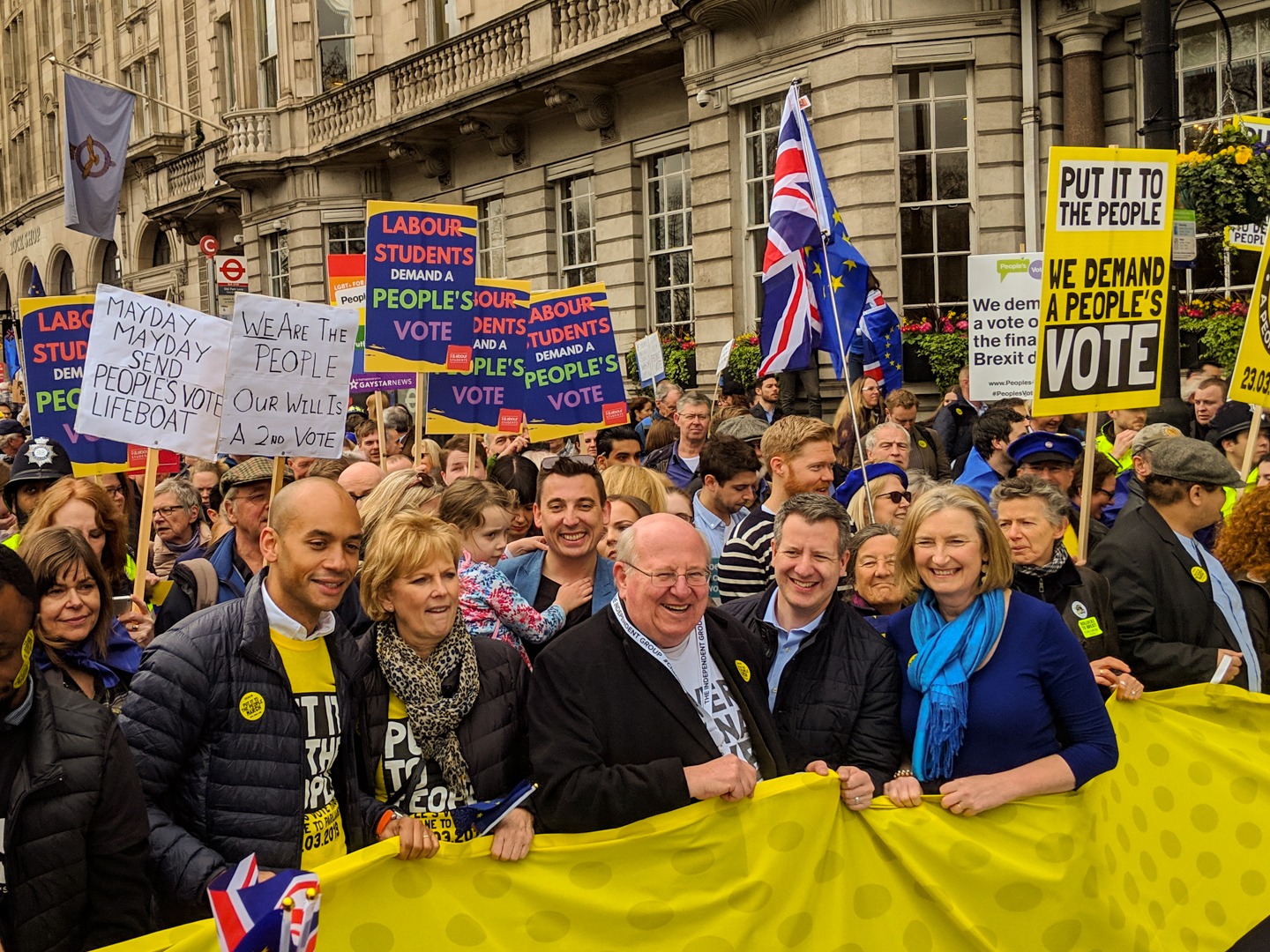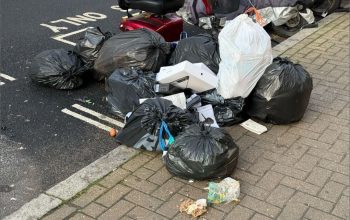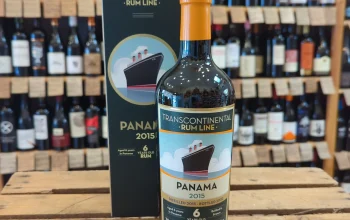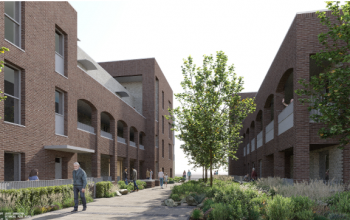An estimated one million people descended on London on Saturday, March 23, to march for a ‘People’s Vote’ on the final outcome of Brexit negotiations.
The march was organised by The People’s Vote campaign and was led by a number of members of the newly formed Independent Group, made up of ex-Labour and Conservative MPs.
Chuka Umunna, Gavin Shuker, Anna Soubry and Mike Gapes were all leading chants, carrying banners and happily talking with their fellow protesters and listening to their views.

Speaking to the Kingston Courier, the Independent Group’s spokesman Chuka Umunna said: “We’re not just going to stand by and let this chaos unfold. We want our say and we want a People’s Vote.
“You’ve got a huge number of people who don’t want to be robbed of their futures, and so that’s what this is all about.
“Just look at the number on the street today, and then compare and contrast with Nigel Farage’s little, small bunch of people. We’ve got hundreds of thousands.”

While the total number is still being debated, the People’s Vote Campaign have claimed the number was as high as 1 million.
An amazing 1 million people are estimated to be marching today at the #PutItToThePeopleMarch
Thank you to everyone who has travelled from every corner of the UK.
It’s time for a #PeoplesVote. Please RT: pic.twitter.com/UOpS74v1r0
— People’s Vote UK (@peoplesvote_uk) March 23, 2019
Some have disputed this figure, with scepticism coming largely from the pro-Brexit camp who also feel that protesters are acting in an undemocratic way by not accepting the democratic process.
Those voices were largely absent during the march, however, and anyone with pro-Brexit opinions would have been lost in the sea of blue and gold of the European Union’s flag.

Protesters met outside the Hilton Hotel in London on Park Lane, with the march due to start at 12pm, but it quickly became clear that the sheer volume of people was going to result in very slow progress along the planned route.
Marchers joined from all different directions, and aerial footage provided by the police and media outlets showed a mass of people that ran from Parliament Square, the final destination of the march, all the way back well past the initial starting point.
The BBC’s aerial footage from the People’s Vote March.
#PeoplesVoteMarch organisers say more than a million people joined protests in central London
[tap to expand]https://t.co/KI8HvOednR #Brexit pic.twitter.com/SeD8az1Ev8— BBC Politics (@BBCPolitics) March 23, 2019

Protesters came from far and wide across the UK, with some having travelled for as long as 15 hours from the Orkney Islands in order to join the march. Twitter was amass with pictures and videos of coaches full of people destined for London.
With many more coaches expected than the previous People’s Vote march in October 2018, organisers were anticipating a turn out larger than the previous march’s estimated 750,000.
Distance did not deter people. One protester wearing a red Jeremy Corbyn hat said: “I’ve been up since five. I’ve come from Cheshire today. It wasn’t that bad, a couple of hours on the train, that’s all.”
“I think he’s stuck between a rock and a hard place, and I think he’s in an impossible situation to please both sides of his party,” she said of Corbyn. “The whole thing should have been cross-party from the beginning.”
Corbyn was a notable absence at the march having announced recently that Labour would support a referendum.

Photo: Chris Jewers
The route taken by the march saw the hundreds of thousands of protesters walk down Park Lane, Piccadilly, St James’s Street, Pall Mall, through Trafalgar Square and down Whitehall before finally ending up at Parliament Square, outside the Houses of Parliament, where a stage had been set up for speeches from prominent members of the People’s Vote movement.
Many young people joined the march, and as a demographic feel particularly aggrieved by the Brexit referendum result. YouGov’s statistics show that 71 per cent of 18-24 year olds voted to remain in the EU, with many suggested the result could have been different had 16-year-olds been allowed to vote.
Should a second referendum be held now, those who were 16 at the time of the referendum could now vote and have the potential to swing the result.
Given that they are the generation who have to live with the consequences of leaving the EU for the longest, they have been particularly vocal about the impact it will have on their future, and it was clear many had made the journey to London to participate in the protests.

The route taken by the march saw the hundreds of thousands of protesters walk down Park Lane, Piccadilly, St James’s Street, Pall Mall, through Trafalgar Square and down Whitehall before finally ending up at Parliament Square, outside the Houses of Parliament, where a stage had been set up for speeches from prominent members of the People’s Vote movement.
Many young people joined the march, and as a demographic feel particularly aggrieved by the Brexit referendum result. 71% of 18-24 year olds voted to remain in the EU, with many suggested the result could have been different had 16-year-olds been allowed to vote.
Should a second referendum be held now, those who were 16 at the time of the referendum could now vote and have the potential to swing the result.
Given that they are the generation who have to live with the consequences of leaving the EU for the longest, they have been particularly vocal about the impact it will have on their future, and it was clear many had made the journey to London to participate in the protests.

Spirits of the people in the march were high, despite the severity of the issue at hand. This was helped by the festival atmosphere that could be felt throughout the march, with marching bands competing with stereo systems over the din of the cheers, chanting, whistle and horn blowing and supportive horn-honking by passing taxi-drivers.
Many were optimistic that a People’s Vote was becoming more likely, which also kept spirits high, and people were praising the peaceful and good-natured atmosphere that was evident throughout the huge crowd.

Those that could fit into Parliament Square by the time the march had made its way through Westminster were greeted by a stage and large screen in front of the green.
The statues of many famous politicians, such as Winston Churchill, David Lloyd George, Nelson Mandela, Abraham Lincoln and Mahatma Gandhi, as well as many thousands of spectators, watched on as Mariella Frostrup, Richard Bacon and other key figures on the People’s Vote campaign made their case for a second referendum on leaving the European Union.
Scottish First Minister Nicola Sturgeon, former deputy prime minister Lord Heseltine, London mayor Sadiq Khan, ex-attorney general Dominic Grieve, Green Party MP Caroline Lucas and SNP Westminster leader Ian Blackford also took the stage.
The protests finished outside the Houses of Parliament where the Brexit debate will continue to rage in the run-up to the latest leaving date of April 12, and beyond.






